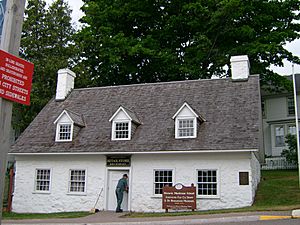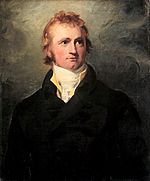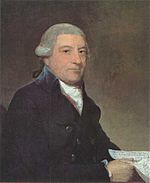American Fur Company facts for kids
 |
|
| Private | |
| Industry | Fur trade |
| Fate | Dissolved |
| Successor | None |
| Founded | New York City, United States (1808) |
| Founder | John Jacob Astor |
| Defunct | 1847 |
| Headquarters |
New York City
|
|
Area served
|
United States and Territories |
The American Fur Company (AFC) was a very important business in the early United States. It was started in 1808 by John Jacob Astor, who was a German immigrant.
Back in the 1700s, animal furs were very popular in Europe. North America became a big supplier of these furs. British companies like the North West Company and the Hudson's Bay Company were major players in this trade. Astor wanted to compete with them.
He used clever business plans and American feelings against the British. His company grew to control most of the fur trade in the United States by 1830. The American Fur Company became one of the largest and richest businesses in the country.
Astor had a big plan. He wanted several companies to work together across the Great Lakes, the Great Plains, and the Oregon Country. This would help him control the fur trade in North America. He planned to ship cheap goods to trading posts. There, they would trade with different Indigenous peoples for fur pelts.
These furs would then go to Guangzhou, China, where they were in high demand. Chinese goods would then be bought and sold in Europe and the United States. Astor also planned a deal with the Russian-American Company. He would supply their posts in Russian America (now Alaska). This would stop his rival, the North West Company, from getting a foothold on the Pacific Coast.
However, the demand for furs in Europe started to drop in the early 1800s. This caused the fur trade to slow down. Astor left his company in 1830. The company went bankrupt in 1842 and finally closed in 1847.
| Top - 0-9 A B C D E F G H I J K L M N O P Q R S T U V W X Y Z |
How It Started
Early Ideas
Before John Jacob Astor started his company in the Oregon Country, other people had similar ideas. They thought about setting up trading stations along the Pacific Coast. Peter Pond, an American fur trader, shared maps of his travels in Canada. He gave them to the U.S. Congress and a British official in 1785.
Pond later helped start the North West Company. He continued trading in Canada. Pond's ideas influenced Alexander Mackenzie. Mackenzie later became the first European to cross North America.
In 1802, Mackenzie suggested a "Fishery and Fur Company" to the British government. He wanted a big trading post on Nootka Island. He also wanted two more posts on the Columbia River and in Alaska. This plan aimed to get around British trade rules and access Chinese markets. But the British government said no.
Another person who influenced Astor was his friend, Alexander Henry. Henry often thought about the potential of the western coast. He called setting up businesses on the Pacific shoreline "my favorite plan." Astor likely discussed these ideas with Henry. Astor was good at using other people's ideas to build his own business.
Trading with China
Astor joined two trips by the North West Company to China in the 1790s. They used American ships to avoid British trade laws. At that time, only the East India Company could trade with China for the British. These trips made a lot of money.
Astor even offered to handle all of the North West Company's fur shipments to China. But Alexander Mackenzie turned him down. This made Astor decide to fund his own trips to China. He became an independent international merchant.
Astor started funding trading trips to China with several partners. Their cargo was often worth a lot of money, including otter and beaver furs. Astor even had a ship called the Beaver built in 1803 to expand his trading fleet.
Starting the Company
By 1808, Astor had built a huge business. It involved furs, teas, and silks, trading across three continents. That same year, he started looking for government support for a fur trading business on the Pacific coast.
He wrote to the Mayor of New York City, DeWitt Clinton. Astor explained that a state license would give his business the official approval it needed. He also asked the U.S. government for military help. This would protect his operations from Native American groups and help him control new markets. However, his big ideas were not officially approved at first. So, Astor kept promoting his plans to important government officials.
He also contacted President Thomas Jefferson. Astor shared a detailed plan for his business. He said it would help America control "the greater part of the fur-trade of this continent." He planned a chain of trading posts. These would stretch across the Great Lakes, the Missouri River, the Rocky Mountains, and end at a fort on the Columbia River.
Once furs were collected from these many outposts, Astor's ships would take them to Guangzhou, China. There, the furs would be sold for huge profits. Chinese goods like porcelain, fabrics, and tea would then be bought. The ships would then sail across the Indian Ocean to sell these Chinese goods in Europe and America.
Company Branches
Pacific Fur Company

To start his plan for trading stations from the Rocky Mountains to the Pacific Northwest, Astor created a branch called the Pacific Fur Company. Astor and his partners met in New York on June 23, 1810. They signed the agreement for the Pacific Fur Company. His partners were former North West Company traders.
From their outpost on the Columbia River, Astor hoped to gain a business foothold in Russian America and China. The Russian-American Company often had trouble getting supplies. Astor saw this as a way to get even more furs. Cargo ships from the Columbia River would sail north to Russian America to bring needed supplies.
Astor hoped that by helping the Russian authorities, he could stop the North West Company or any other British presence from being set up on the Pacific Coast. In 1812, a deal was signed. It allowed Astor's merchant ships to carry furs from Russian America into China.
The Pacific Fur Company struggled during the War of 1812. The chance of the British Royal Navy taking over forced the company to sell all its property in the Oregon Country. This was made official on October 23, 1813. The British flag was raised at Fort Astoria. On November 30, a British ship arrived at the Columbia River. Fort Astoria was renamed Fort George in honor of King George III.
After the North West Company joined with the Hudson's Bay Company in 1821, the Hudson's Bay Company controlled most of the fur trade in the Pacific Northwest. This meant Astor's dream of a global business network was actually achieved by his British rivals.
South West Company
The South West Company handled the fur trade in the Midwest and Southwest. In the Midwest, it competed with local companies along the upper Missouri, upper Mississippi, and Platte rivers. It also traded as far south as New Mexico.
These competitors were mostly companies from St. Louis, Missouri. They were active in the fur trade and general merchandise. They were often started by French families, like the Chouteaus. Sometimes, competition in the wilderness led to fights and attacks.
In 1834, the American Fur Company sold its Western Division. It went to Bernard Pratte and Pierre Chouteau Jr., who they had already worked with. Chouteau continued the business under a new name.
Later Years
For a while, it seemed like the company might be finished. But after the War of 1812, the United States passed a law. It stopped foreign traders from working in U.S. territory. This meant the American Fur Company no longer had to compete with Canadian and British companies. This was especially true around the Great Lakes and in the West.
The AFC competed fiercely with other American companies. It wanted to create a monopoly (meaning it would be the only one) in the Great Lakes region and the Midwest. In the 1820s, the AFC expanded its control into the Great Plains and the Rocky Mountains. By the mid-1830s, it dominated the fur trade in what became Montana. To control the industry, the company bought out or defeated many smaller competitors. One example was the Rocky Mountain Fur Company.
By 1830, the AFC almost completely controlled the fur trade in the United States. But the company's time at the top of America's business world did not last long. John Jacob Astor sensed that furs would become less popular in fashion. So, he left the company in 1834.
The company then split into smaller parts. The Northern Division of the Midwestern part kept the name American Fur Company. It was led by Ramsay Crooks. To save money, it started closing many of its trading posts.
Decline
Throughout the 1830s, competition started to appear again. At the same time, there were fewer furs available in the Midwest. During this period, the Hudson's Bay Company tried to hurt the American fur companies. They did this from their main base at Fort Vancouver.
They reduced the number of furs in the Snake River area. They also sold furs for less money than the American Fur Company at the yearly Rocky Mountain Rendezvous. This effectively ruined American fur trading efforts in the Rocky Mountains. By the 1840s, silk was replacing fur for hats in Europe.
The company could not handle all these problems. It tried to make money by going into other businesses, like lead mining. But the American Fur Company still failed. The company's assets were divided into several smaller businesses. Most of these also failed by the 1850s. After 1840, the American Fur Company's business declined. John Jacob Astor had already sold his part of the company in 1834. He invested his money in land in New York City. He became the richest man in America.
Influence
When it was at its peak, the American Fur Company was one of the biggest businesses in the United States. By the 1820s, it had a complete monopoly on the profitable fur trade in the young nation.
Through his profits from the company, John Jacob Astor made many smart land investments. He became one of the richest people in the world and the first person in the United States to be a multi-millionaire.
Astor, who was born in Germany, is ranked as one of the wealthiest people of all time. He used some of his money to start the Astor Library in New York City. This library later joined with another to form the New York Public Library.
On the frontier, the American Fur Company helped open the way for people to settle and develop the Midwestern and Western United States. Mountain men who worked for the company improved Native American trails. They also created new paths that led settlers into the West. Many cities in the Midwest and West, like Fort Benton, Montana, and Astoria, Oregon, grew around American Fur Company trading posts. The company played a big role in the growth and expansion of the young United States.
See also
 In Spanish: American Fur Company para niños
In Spanish: American Fur Company para niños




